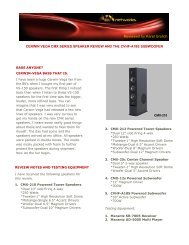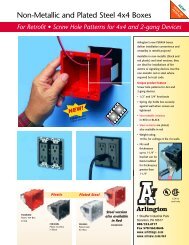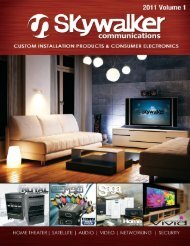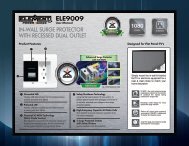STEREO POWER AMPLIFIER - a1Components
STEREO POWER AMPLIFIER - a1Components
STEREO POWER AMPLIFIER - a1Components
You also want an ePaper? Increase the reach of your titles
YUMPU automatically turns print PDFs into web optimized ePapers that Google loves.
<strong>STEREO</strong> <strong>POWER</strong> <strong>AMPLIFIER</strong><br />
CHO4020 100 watt<br />
CHO4021 200 watt<br />
CHO4022 400 watt<br />
Page 1
WARNING: When using electrical products, basic precautions should<br />
always be observed, including the following:<br />
1. Read these instructions thoroughly and retain for future reference.<br />
2. Head all warnings, and follow all instructions.<br />
3. Do not use this apparatus near water.<br />
4. Clean only with a dry cloth.<br />
5. Do not block any of the ventilation openings. Install in<br />
accordance with manufacturer’s instructions.<br />
6. Do not install near any heat sources such as radiators, heat<br />
registers, stoves or other apparatus (including amplifiers) that<br />
produce heat.<br />
7. Do not disable the safety purpose of the polarized plug, or<br />
grounding-type plug. A polarized plug has two blades with one<br />
prong wider than the other. A grounding plug has two blades and<br />
a third grounding prong. The wide blade or third prong is<br />
provided for your safety. Never break off the ground pin. Connect<br />
only to a power supply of the type marked on the unit adjacent to<br />
the power supply cord. If the provided plug does not fit into your<br />
outlet, consult an electrician for replacement of the obsolete<br />
outlet.<br />
8. Protect the power cord from being pinched or stepped on,<br />
particularly at plugs, convenience receptacles, and the point at<br />
which they exit from the apparatus.<br />
9. Use only those attachments/accessories provided by the<br />
manufacturer.<br />
10. Unplug this apparatus during lightning storms, or when unused for<br />
long periods of time.<br />
11. Refer all servicing to qualified service personnel. Servicing is<br />
required when the apparatus has been damaged in any way, such<br />
as: power cord or plug is damaged, liquid has been spilled or<br />
objects have fallen into the apparatus, the apparatus has been<br />
exposed to rain or moisture, the apparatus does not operate<br />
normally or the apparatus has been dropped.<br />
12. If this apparatus is to be mounted in an equipment rack, rear<br />
support should be provided.<br />
13. Exposure to extremely high noise levels may cause permanent<br />
hearing loss. Individuals vary considerably in susceptibility to<br />
noise-induced hearing loss, but nearly everyone will lose some<br />
hearing if exposed to sufficiently intense noise for a sufficient<br />
time. The U.S. Government’s Occupational and Health<br />
Administration (OSHA) has specified the following permissible<br />
noise level exposures:<br />
Duration per Day in Hours Sound Level dBA, Slow Response<br />
8 90<br />
6 92<br />
4 95<br />
3 97<br />
2 100<br />
1-1/2 102<br />
1 105<br />
1/2 110<br />
1/4 or less 115<br />
According to OSHA, any exposure in excess of the above permissible<br />
limits could result in some hearing loss. Ear plugs or protectors to the<br />
ear canals or over the ears must be worn when operating this<br />
amplification system in order to prevent a permanent hearing loss, if<br />
exposure is in excess of the limits as set forth above. To ensure<br />
against potentially dangerous exposure to high sound pressure levels,<br />
it is recommended that all persons exposed to equipment capable of<br />
producing high sound pressure levels such as this amplification system<br />
be protected by hearing protectors while the unit is in operation.<br />
Page 2
CAUTION: Risk of electrical shock<br />
DO NOT OPEN!<br />
CAUTION: To reduce the risk of electric<br />
shock, do not remove cover. No user serviceable parts<br />
inside. Refer servicing to qualified service personnel.<br />
WARNING: To prevent electrical shock or fire hazard,<br />
this apparatus should not be exposed to rain or<br />
moisture, and objects filled with liquids, such as vases,<br />
should not be placed on this apparatus, Before using<br />
this apparatus, read this operating guide for further<br />
warnings.<br />
Congratulations!<br />
You have just purchased a highly reliable, professional Choice<br />
Select Power Amplifier. These amplifiers are ruggedly<br />
constructed rack mount units with numerous input/output<br />
connections for installation flexibility and convenience. Front<br />
panel features include calibrated gain (dB) controls with LED<br />
power level indicators.<br />
Modern power amplifiers are sophisticated pieces of engineering<br />
capable of producing extremely high power levels. They will<br />
provide many years of reliable service.<br />
Correctly installing and connecting the amplifier is very<br />
important. Please take the time to study this manual so that you<br />
can obtain the best possible service for your amplifier.<br />
Page 3
2. SETUP<br />
2.1 Unpack Your Amplifier<br />
Please unpack and inspect your amplifier<br />
for any damage that may have occurred<br />
during transit. If damage is found, notify the<br />
transportation company immediately. Save<br />
the shipping carton as evidence of damage<br />
for the shipper’s inspection.<br />
It is also recommended that you save all<br />
packing materials so you will have them if<br />
you ever need to transport the unit. Never<br />
ship the unit without adequate packing.<br />
YOU WILL NEED (not supplied):<br />
• Input wiring cables<br />
• Output wiring cables<br />
WARNING: Before you start to<br />
set up your amplifier, make sure you<br />
read and observe the Important Safety<br />
Instructions found at the beginning of<br />
this manual.<br />
2.2 Install Your Amplifier<br />
CAUTION Before you begin, make<br />
sure your amplifier is disconnected from<br />
the power source, with power switch in<br />
the “OFF” position and all level controls<br />
turned completely down (counterclockwise).<br />
This amplifier may be rack-mounted using a<br />
standard 19-inch equipment rack. See<br />
Figure 2.2 for amplifier dimensions. You<br />
may also stack amps without using a<br />
cabinet.<br />
NOTE: When transporting, amplifiers<br />
should be supported at both front and back.<br />
2.3 Ensure Proper Cooling<br />
When using an equipment rack, mount<br />
units directly on top of each other. Close<br />
any open spaces in rack with blank panels.<br />
DO NOT block front or rear air vents. The<br />
side walls of the rack should be a minimum<br />
of 2 inches away from the amplifier sides,<br />
and the back of the rack should be a<br />
minimum of 4 inches from the amplifier<br />
back panel.<br />
Figure 2.2 Amplifier Dimensions<br />
Page 4
2.4 Choose Input Wire and Connectors<br />
You have 3 choices of input connectors:<br />
1/4-inch phone, 3-pin XLR, or RCA inputs.<br />
You can also use either balanced or<br />
unbalanced wiring.<br />
Figure 2.4.1 shows balance connector pin<br />
assignments for XLR and phone. Figure<br />
2.4.2 shows unbalanced connector pin<br />
assignments for XLR and phone. RCA<br />
connectors are unbalanced.<br />
Both channels should be wired using a<br />
common center terminal for ground<br />
connection.<br />
NOTE: Custom wiring should<br />
only be performed by qualified<br />
personnel.<br />
Figure 2.4.1 Balanced Input<br />
Connector wiring<br />
Figure 2.4.2 Unbalanced Input<br />
Connector wiring<br />
Page 5
2.5 Choose Output Wire and Connectors<br />
Choice Select recommends using pre-built or professionally wired,<br />
high-quality, two-or four-conductor, heavy gauge speaker wires. They<br />
should be terminated with Neutrik Speakon NL4FC connectors<br />
(Figure 2.5.1) at one end and appropriate connectors to fit your<br />
speakers at the other end.<br />
Using the guidelines below, select the appropriate size of wire based<br />
on the distance from amplifier to speaker.<br />
Figure 2.5.1 Neutrik Speakon Connector<br />
Distance<br />
Wire Size<br />
Up to 25 ft.<br />
16 gauge<br />
26-40 ft. 14 gauge<br />
41-60 ft. 12 gauge<br />
61-100 ft. 10 gauge<br />
101-150 ft. 8 gauge<br />
151-250 ft. 6 gauge<br />
CAUTION: never use shielded cable for output wiring.<br />
Figure 2.5.2 The Binding Post Output Connectors can be<br />
direct-wired oor will accept banana plugs.<br />
Page 6
2.6 Wire Your System<br />
2.6.1 Stereo Mode<br />
Make sure the amplifier is turned off and<br />
the level controls are turned down before<br />
you wire the system.<br />
Typical input and output wiring is shown in<br />
Figure 2.6.1.<br />
INPUTS: Connect input wiring for each<br />
channel.<br />
OUTPUTS: Maintain proper polarity (+/-)<br />
on output connectors.<br />
Connect Channel-1 positive (+) speaker<br />
load to Channel-1 positive terminal of amp;<br />
repeat for negative (-). Repeat each<br />
channel wiring as for Channel-1. Make sure<br />
the Mode switch is set to the “Stereo”<br />
position when operating in Stereo mode.<br />
(See the next page for Bridge-Mono wiring.)<br />
Figure 2.6.1 Typical System Wiring, Stereo Mode<br />
Page 7
2.6.2 Bridge-Mono Mode<br />
Make sure the amplifier is turned off and<br />
the level controls are turned down before<br />
you wire the system.<br />
Typical input and output wiring is shown in<br />
Figure 2.6.2.<br />
INPUTS: Connect input wiring to CH 1.<br />
OUTPUTS: We recommend direct wiring to<br />
the binding posts for bridged mono<br />
operation. Connect the speaker (load) using<br />
both of the red binding posts. Do not use<br />
the black posts in the Bridged mode.<br />
Make sure the Mode switch is set to the<br />
“Bridge Mono” position when operating in<br />
Bridge-Mono mode.<br />
NOTE: Turn down the Channel 2 level<br />
control when operating the channel pair<br />
in Bridge-Mono mode, as the Channel 1<br />
level control works both channels.<br />
Figure 2.6.2 Typical System Wiring, Bridge-Mono Mode<br />
Page 8
3. Operation<br />
NOTE: For use in the USA, power switch (located above “AC INPUT” on back panel) should be set to “110/120V 50-60Hz” position.<br />
NOTE: In rare situations a ground loop may produce an AC hum. “Lifting” the ground may eliminate the hum. However, to be properly grounded the<br />
“Lift/Ground” switch should be set to “Ground”. The amplifier will not be grounded if the switch is set to “Lift”.<br />
Page 9
SPECIFICATIONS<br />
2-channel<br />
Stereo Output<br />
(8 ohm load)<br />
Bridge-Mono<br />
Output<br />
(4 ohm load)<br />
Power<br />
Consumption<br />
CHO4020 CHO4021 CHO4022<br />
100 watts RMS 200 watts RMS 400 watts RMS<br />
200 watts 400 watts 800 watts<br />








